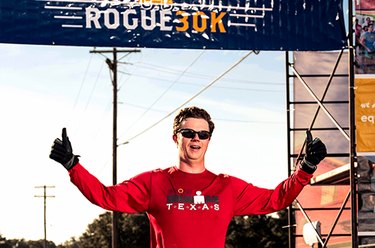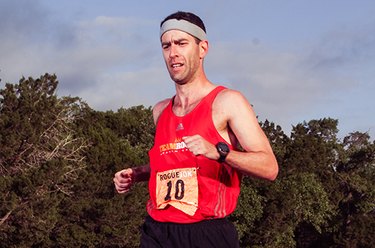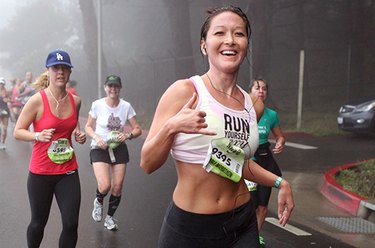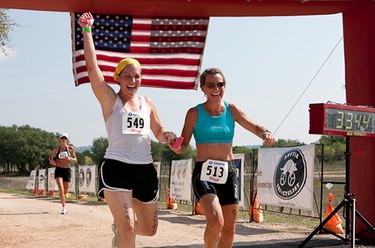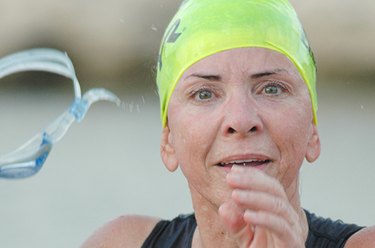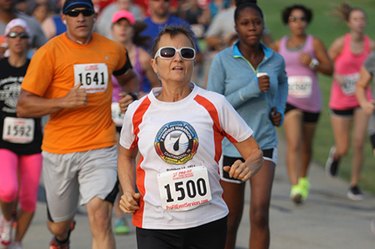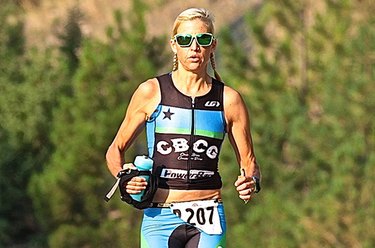Runners love analyzing their races, calculating their pace and finding lessons to apply to the next race. One important part of recounting the race is looking at photos and reliving the excitement. How can you make sure you get — and take — the best race-day photos?
We talked to five professional race photographers to get their tips for both runners and their family and friends taking photos to make sure you get the best race-day mementos possible. Read on as the pros share their expertise and example race-day photos.
Video of the Day
Video of the Day
1. Run Through the Finish Line
Josh Baker, owner and main photographer of AzulOx Photography, learned this after shooting the New York and Austin marathons. "As you cross the finish line, don't stop your watch, just run 10 to 15 feet through the finish line and throw your hands up," he says.
This is important because photographers aren't taking your picture until you have gone past the finish line. That way, they can get the finish line and clock behind you. If you are beneath it when the picture is taken, it is too big in relation to you. For the best finish-line photo, take Josh's advice and wait to check your chip time instead of your watch.
Read more: 17 Proven Motivations to Get You Running
2. Wait for the Runner to Fill Your Frame
If you are on the other side of the camera during the race, be sure to not get too click-happy and take a photo right when your runner appears. Josh Baker, of AzulOx Photography, says, "It takes patience to wait for your runner for the best photo, but you need to wait until they are almost on top of you."
Additionally, if you get low and wait for the runner to fill your frame, you have the best chance of a great race photo. If you don't have optimal zoom, it helps to let your runner know what side of the course you plan to be on so you can fit them in the frame properly.
3. Remember the ‘Mona Lisa’ Factor
Sean Walkinshaw, the director of business development for MarathonFoto.com, reminds runners to smile. "A smiling face and/or gesture can take a photo to a whole new level and create a connection to the viewer of the image," he says. He also suggests participating and engaging with the photographer, while still expressing your exact feeling at that moment.
"Whether you are feeling great or completely exhausted, your mannerism and/or expressions can transcend the image when you engage back." The "Mona Lisa" factor, as he calls it, means your race photos will be infectious because you're being true to yourself. So don't be afraid and show your real emotions!
4. Research the Course Before the Race
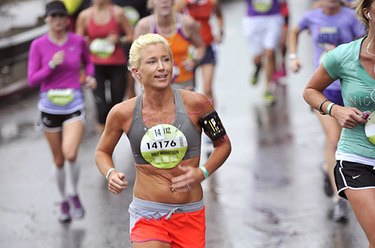
If you are taking photos the day of the event, Sean Walkinshaw of MarathonFoto.com suggests scouting the location prior to the race. "When researching, do so during similar ambient lighting patterns that will contribute to the photo by enhancing the background," he says.
Think about the characteristics of the roadway and event-production signage and build-outs too. This can be seen in the photo above. "I chose a road that was descending on a slight curve to enhance the trail of runners following my subject, but also selected a piece of the road that was wet to create a reflection," Walkinshaw says. Even the hilliest of courses can enhance your runner and the resulting photo.
Read more: The Best 5K Races for Any Fitness Level
5. Don’t Hit Your Pose Too Far Out
Jake North, owner of Jake North Photography in Austin, Texas, has photographed both trail and road races and, unfortunately, has seen runners miss out on some great photos. For the best photos, he says, "If you are smiling or posing for a race picture, don't hit your pose too far out."
He recommends runners wait until they are five to 10 yards from the photographer. "I see so many great poses that I just can't reach because the runners pose when they see the lens." Instead, wait until you are close enough to fill the camera's frame. This gives you the best chance of a great race-day reminder!
6. Don’t Use Your Camera's Auto-Focus
To make sure your runner is the focus of your photo, it is important to have a good camera and set the auto-focus yourself. Photographer Jake North says, "All good cameras have auto-focus, but the default camera setting is for the camera to pick the spot to focus on. Sometimes, it can't tell from all of the moving objects in the frame which one to focus on, and the camera often chooses incorrectly."
You can help improve your consistency by setting your camera to Servo if you have a Canon or Constant Focus if you have a Nikon, and then set the auto-focus point a third away from the bottom in a portrait-oriented frame. "Put that auto-focus point on the runner's face (or the closest runner in a group) and voila!"
7. Keep an Eye Out for Race Photographers

Andrew Wolfe, owner and head photographer at PhotoWolfe.com, has a lot of experience taking photos for races and triathlons throughout Central and South Texas. He suggests runners actively look for race photographers to have the best chance of getting a great photo.
"If you want to give yourself a better chance of having a photo taken, slow down and create a little space between yourself and the runner ahead of you," he says. If you are too close to other runners, there is a good chance you may get blocked. But also, don't be shy about getting the shot you want. "If you see a photographer before/after the race, feel free to ask them to take a photo of you or your group," Wolfe says.
8. Take Plenty of Test Shots
For the best shot of your runner, it's helpful to take a few test photos of other runners as they pass by. Photographer Andrew Wolfe also recommends you "take a few shots of your runner with friends and family before the race, when you are all looking your best.
"Along with test shots, check the shadows on the course and try to eliminate them as much as possible by changing where you are standing on the side of the course. This is another time where test shots can be beneficial. And don't forget to take that all-important, end-of-race photo of your runner with their bib and medal!
9. Keep Clear of Photographers in the Finish Area
Rick Kent, a professional sports photographer and the owner of Enduro Photo, has photographed XTERRA races, half marathons and more. "Never get in the way of professional photographers, especially in the finish area," he says.
As runners who have participated in races know, the starting area, the course and the finisher's chute are constantly packed with people, all looking for their friends and family and getting caught up in the excitement of the day. By looking out for photographers and making sure you don't block them, everyone on course has the opportunity for an equally great photo.
Read more: 12 Running Mistakes You Could Be Making
10. Smartphones Aren't for Action Shots
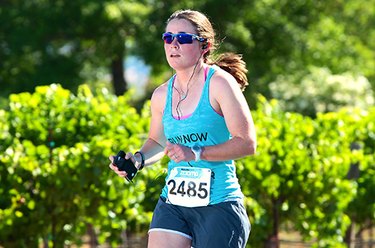
For photographers using smartphones to take photos of their runners during the race, remember they are not designed to capture action and motion very well, says photographer Rick Kent. If you still want to use your phone to document your runner, consider using video to capture the action instead, and save your smartphone's camera for posed shots before and after the race.
Another tip to keep in mind for those pre-and post-race photos is to not "bull's-eye" the runner's face. Kent says that the face should go much higher in the frame. It is possible to use a smartphone to capture your runner's day flawlessly!

